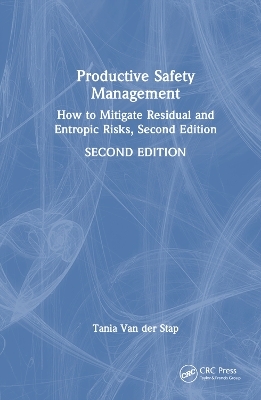
Productive Safety Management
CRC Press (Verlag)
978-1-032-70157-8 (ISBN)
This book discusses the realm of operational risk management, exploring the intricacies of managing safety, production and quality simultaneously. It offers a fresh perspective on the dynamic and complex nature of risk, highlighting the ever‑changing landscape that organisations must navigate. The reliance on current understandings of residual risk is deficient, particularly as systems of production are prone to degradation over time. This degradation leads to an increase in ‘entropic risk’, resulting in losses in daily production that, if left unchecked, could culminate in catastrophic consequences.
Productive Safety Management, second edition utilises practical experience to offer context and application to the concepts surrounding risk that are introduced. It explores the residual and entropic risks present in production systems before shifting focus to the same risks within organisational elements such as leadership, competencies, management systems and resilience. The degradation of these factors can lead to a toxic enterprise culture. Traditional risk management methods have resulted in the creation of functional silos. This book advocates for a multidisciplinary approach, positioning it as essential reading for the Fourth Industrial Revolution. In this era, the ability to effectively manage risks and capitalise on opportunities will be crucial for operational success.
This comprehensive title is designed for operational managers and supervisors, and risk‑related professionals in engineering, OSH, environment and quality management.
Tania Van der Stap spent the last 20 years since writing the first edition of Productive Safety Management in managerial and technical positions responsible for safety, health and environmental management. Having experience in staff and contractor roles means she understands how to achieve results, whether within the organisation, owners’ team, project team or as an external technical expert. The industries and organisations she’s worked in have been diverse – gas, mining, exploration, construction, rail transport, engineering, agribusiness, professional organisations and regulatory authorities. She has in‑depth knowledge of different strategies according to each organisation’s level of maturity, leadership capability, resource availability and most importantly, the operational reality of the enterprise. Tania’s qualifications are in commerce, which have throughout her career resulted in a business lens on operational performance. She is an unequivocal advocate of a risk‑ and opportunity‑based approach to HSE, production and quality.
Tania Van der Stap spent the last 20 years since writing the 1st edition of Productive Safety Management in managerial and technical positions responsible for safety, health, and environmental management. Having experience in staff and contractor roles means she understands how to achieve results, whether within the organisation, owners’ team, project team or as an external technical expert. The industries she’s worked in have been diverse - gas, mining, exploration, construction, rail transport, engineering, agribusiness, professional organisations, and regulators. She has in-depth knowledge of different strategies according to each organisation’s level of maturity, leadership capability, resource availability and most importantly, the operational reality of the enterprise. Tania’s qualifications are in Commerce (not HSE), which has throughout her career, resulted in a business lens on operational performance. She is an unequivocal advocate of a risk- and opportunity-based approach to HSE, production and quality.
Foreword
About the Author
Introduction
Introduction References
Chapter 1: The Entropy Model and Systems of Production
Chapter Extract
The Nature of Risk
What is ‘Entropic Risk’?
The Entropy Model: A Systems Approach
The Four Steps Risk Management Strategy
The Total Risk Profile
The Cyclical Risk of Failure Following Success
Summary
Chapter References
Chapter 2: The Path to Organisational Maturity 36
Chapter Extract
The Alignment Fallacy
The Three Levels of Alignment
Integrating ISO Standards
An Alternative to Accreditation
Learning from the ESG Agenda
The Multidisciplinary Approach
Summary
Chapter References
Chapter 3: Processes
Chapter Extract
The Interface Between Systems of Production
Minimal Compliance
The Path to Maturity and Self-Regulation
Complexity and Management of Work Practices
The ALARP Assumption
Summary
Chapter References
Chapter 4: Technology
Chapter Extract
Residual Risk and Design
Managing Technological Risks
Case Studies: Technological Disasters
The Human – Technology Interface
Maintenance of Technology
Technology in the Fourth Industrial Revolution
Summary
Chapter References
Chapter 5: Physical Environment
Chapter Extract
Residual Risk and Design
“Acts of God”
Managing Physical Environment Risks
The Workplace in the Fourth Industrial Revolution
Summary
Chapter References
Chapter 6: Human Resources
Chapter Extract
A Systems Approach to Human Resources Risks
Human Resource Risk Management Strategies
Production Pressure and Safety Violations
HR Risks in the Fourth Industrial Revolution
Summary
Chapter References
Chapter 7: Risk Quantification and Management Strategy
Chapter Extract
The ALARP Assumption Revisited
Current Risk Assessment Tools
Dynamic Combinations Risk Method
Residual Risk Management Strategies (RRMS)
Case Study: Residual Risk Analysis
Entropic Risk Prevention Strategies (ERPS)
Case Study: Entropic Risk Analysis
Worker Exposure: The Complete Profile
Summary
Chapter References
Chapter 8: Risk Leadership
Chapter Extract
The Entropy Model and Organisational Factor Risks
Situational Leadership for Operations
Practical Risk Leadership and Decision-Making
OSH Management Systems and Legacy Issues
Summary
Chapter References
Chapter 9: Operational Capacity
Chapter Extract
Risk-Taking versus Risk-Managing Behaviour
Day-to-Day Leadership for Supervisors
Capacity in Reserve, Resilience and Resourcefulness
Summary
Chapter References
Chapter 10: Towards High Reliability Organisations (HROs)
Chapter Extract
Industry Gaps in Risk Management
Risk Management in HROs
10 Strategies on the Path to High Reliability
Summary and Concluding Comments
Chapter References
Index
| Erscheinungsdatum | 03.12.2024 |
|---|---|
| Zusatzinfo | 6 Tables, black and white; 29 Line drawings, black and white; 29 Illustrations, black and white |
| Verlagsort | London |
| Sprache | englisch |
| Maße | 156 x 234 mm |
| Gewicht | 698 g |
| Themenwelt | Naturwissenschaften ► Biologie ► Ökologie / Naturschutz |
| Wirtschaft ► Betriebswirtschaft / Management ► Allgemeines / Lexika | |
| Wirtschaft ► Betriebswirtschaft / Management ► Personalwesen | |
| Wirtschaft ► Volkswirtschaftslehre | |
| ISBN-10 | 1-032-70157-9 / 1032701579 |
| ISBN-13 | 978-1-032-70157-8 / 9781032701578 |
| Zustand | Neuware |
| Informationen gemäß Produktsicherheitsverordnung (GPSR) | |
| Haben Sie eine Frage zum Produkt? |
aus dem Bereich


